Live fence in the country, what to plant, how to make a live fence, gardeners' advice
Increasingly, in summer cottages, you can find a hedge of living plants. Even backyard owners who are not endowed with gardening experience are able to create similar beauty in their backyards. However, when deciding to create a living fence, it is important not to forget about the need for systematic plant care. Creating a living fence in the country, what to plant is the first question that arises for a summer resident.
Types of living fences
There are several types of hedges, so everyone can choose exactly the option that will help solve a specific problem. For example, owners of private houses who want to protect their territory from uninvited guests and animals should use thorny shrubs with high and strong trunks. Gardeners who want to divide the territory into zones should use herbaceous, climbing plants.
A vegetable hedge can differ in a number of ways and be:
- high / medium / low;
- evergreen and deciduous;
- designed as a designer / freely growing;
- solid or translucent;
- cascade / single-tier;
- mixed or homogeneous.
For framing paths, highlighting the borders of flower beds, you can plant both shrubs and perennial plants like lilies, peonies.
Classification of hedges in relation to height
|
Hedge type |
Suitable plants |
|
Curbs, the height of which does not exceed 100 cm |
Japanese quince, heather and Japanese spirea, brilliant honeysuckle |
|
Fence, the height of which is within 100-300 cm |
western thuja, hawthorn, mock orange and barberry |
|
Living wall. more than 3 m high |
spruce and hornbeam, white willow and thuja. |
The combination of metal, wood and stone fences with hedges looks very attractive. However, in this case, it is important to thin out the plants in order to prevent thickening.
The fast-growing type of living fence is of little use for clipped hedges, but is ideal for creating a living wall.
What can be planted as a living fence
There are several varieties of plants that can be used as a hedge. Below are the most popular ones.
Curly
The weaving species of plants is a fashionable solution for landscaping a private area. With the help of a climbing plant, you can decorate unremarkable objects located on the site. Selecting a plant for planting should be taking into account:
- climatic features;
- features of caring for a shrub / tree;
- preferences of the owner of the site.
Curly perennials are the most convenient option for landscaping the site. Below are the most popular plants from this category that are suitable for creating a living fence.
Climbing grapes
A perennial needs systematic care. In the early years, the plant needs:
- regular soil moistening;
- formation;
- tying up to the supports.
Plants are no less popular by type:
- ivy;
- hops;
- large-leaved woodworm.
Ivy
Ivy is a plant that perfectly masks any error on the fence and allows you to hide unattractive objects located near the fence. Ivy is able to catch on the slightest unevenness. The plant is frost-resistant and shade-loving.It is very important to systematically moisten the soil, which contributes to the full development of the root system.
In addition, to create a living fence, you can use other climbing plants, such as:
- Ornamental beans are annuals with red-orange flowers. The culture does not tolerate frosts, so experts recommend planting beans in late spring.
- Sweet pea is an annual with a subtle and very pleasant aroma.
- Kobei, a liana-like plant blooming with bells, vaguely resembles a waterfall.
- Nasturtiums are an ornamental annual with plush, velvety, lemon-toned flowers. Nasturtium reaches a height of 400 cm.
- Ipomoea is an annual with the presence of crimson and purple flowers. It is best to plant morning glory in open ground in mid-April, as soon as the threat of night frosts has passed. The culture is not capricious, there are no difficulties in leaving.
Shrubs
You can make a hedge by planting shrubs near the fence. Below are the plants that are best suited for this purpose.
Hawthorn
An unpretentious culture will easily take root in a new place. During the period of flowering, ripening of berries, the plant acquires an amazing appearance. The height of the culture reaches 600 cm. There are long thorns on the branches. The berries of the culture are endowed with a number of medicinal properties.
Yellow acacia
There are many varieties of culture. To create a hedge, experts recommend using a yellow acacia, which can be cut to give the shrub the desired shape. Each of the bushes is distinguished by abundant growth. The culture can be propagated by seed.
Barberry
Barberry has a fast engraftment. The plant does not require complex care and looks great as a curb fence and for zoning the territory. On one bush, you can find multi-colored foliage, painted in:
- green;
- red;
- yellow;
- burgundy shades.
The yellow flowers and lilac-black berries make the shrub attractive. The Thunberg deciduous barberry can be used for both freehand and sheared hedges.
Euonymus
Euonymus is very often used in landscape design. Closer to May, bright pink and white inflorescences appear on the bush. In the summer, the shrub, due to the presence of an openwork crown, resembles the appearance of an impenetrable lush carpet. In the middle of autumn, the foliage is painted in yellow, red, purple tones. Bright fruits remain on the branches until winter.
Cotoneaster
The decorative culture has a dense crown. In the warm season, the foliage of the plant is painted in green shades. In autumn, the foliage turns red, black and bright red berries form on the branches. A cotoneaster can grow in the same place for over 40 years. The time for pruning the plant is selected depending on the type of shrub.
Lilac
The lilac hedge has an indescribable beauty that can be observed during the flowering period of the plant. Bright aromas that emanate from the flowers are carried throughout the entire territory of the site. The gradually growing lilac creates a green fence that tightly closes the site from prying eyes. Gardeners recommend planting the Amur type of lilac, which does not require frequent watering and is able to protect the yard from exhaust gases. The bushes are pruned after flowering. The upper part is not affected.
Trees
Trees can also be used to create hedges.
And you
Experts identify more than 100 varieties of willow. These trees are often used in the construction of a high mesh fence of willow shoots. The creation of a live fence is carried out in the spring in stages:
- We dig a trench no more than 30 cm deep and fill the depression with fertile soil.
- Willow twigs, which were previously in the stimulator, are set in the ground.
- After 2-3 weeks, the cuttings begin to grow on their own.
- Near the cuttings, supports are dug in, between which the wire is stretched. The willow rods are fixed to the support, which allows you to shape the fence into the desired shape.
Needles
Often, conifers are used to create a hedge. The most popular ones are presented below.
- Spruce is a hardy tree that can grow in a shaded area. It is recommended to plant seedlings in fertile and moist soil.
- Yew is a plant that should not be planted in areas where small children walk. Yew berries are poisonous. In order for the culture to fully develop, it is important to plant a seedling in fertile soil.
- Thuja can be used in two varieties - eastern and western columnar. The first option will be cheaper, but the care of oriental thuja should be regular. Plants need to be trimmed to maintain an attractive appearance. Western thuja will help create a narrower and tidier fence.
Which plants are best not to use and why
If the site is small, then it is best to abandon such plants as rose hips, sea buckthorn, lilac and hawthorn. They will take up too much space and create additional shading.
For zoning the site, it is better to abandon flowering shrubs. Such plants require frequent pruning, so the flower shoots are removed and the culture loses its original appearance.
If you have small children, you should not plant yew along the fence, the berries of which are poisonous.
What will grow quickly and beautifully in the Urals
In order to create a hedge in the Urals, gardeners recommend using:
- Spirea is an unpretentious, flowering shrub whose height reaches 150 cm. You can choose varieties that bloom with pink or white flowers. Before the start of flowering and growth of the spirea, 2 years should pass.
- Chokeberry - a flowering crop that gives the owner a good harvest. The tree tolerates pruning well.
- A maiden grape, which in just three months is able to braid a huge territory and create a secluded corner on the site.
In Siberia
For planting plants in Siberia, it is important to select exactly those crops that can withstand severe frosts. Therefore, the ideal option for a hedge in Siberia will be:
- Common spruce with long needles. Trees grow quickly, adding 45-55 cm annually. Coniferous culture tolerates pruning and creates a dense fence.
- Siberian fir with soft branches. The dense crown will perfectly protect the area from gusty winds and hide the area from prying eyes.
- The brilliant cotoneaster is a medium-sized crop that grows slowly. Each bush is covered with glossy foliage. The cotoneaster is not prone to diseases and tolerates frost steadily, which is undoubtedly a significant advantage.
In the Moscow region
To create a fence in the Moscow region, you can use:
- Serbian spruce, which reaches a height of 4-5 m. The crown diameter is 8 m. Spruce belongs to unpretentious crops that are resistant to pests.
- Barberry Thunberg is an ornamental plant that attracts attention with its multi-colored foliage, painted in yellow, brown and pink tones. Barberry is resistant to fungal infections.
- Maiden grapes are an unpretentious liana shrub with carved foliage, which in a short period of time braids huge sections of the fence. The culture grows well even in a shaded area. Regular pruning keeps you in shape.
How to divide a site into zones
Dividing the site into zones, the owners of the territory often allocate a recreation area with an average hedge, the height of which does not exceed 150 cm. Borders, in turn, can emphasize garden paths, flower beds, playgrounds and a barbecue area. For curbs, low fences are used, 80-100 cm high.To create a living fence around the yard, plants such as:
- lilac;
- hawthorn;
- viburnum;
- elder.
To create a sheared hedge, you can use euonymus, privet, cotoneaster. Combining variegated crops with green shrubs, you can make a living fence the highlight of the garden.
For borders, landscape designers advise using dwarf barberry, spirea, mountain pine, lingonberry, juniper and dwarf spruce. The flower garden is also beautifully highlighted by lavender, sage, hosta and carnation planted around the perimeter.
How to make a live fence
When choosing a planting material, it is important to pay attention to its quality. It is best to purchase a plant in a specialized nursery or garden center. The seedlings should be approximately the same size to prevent uneven stretching and overgrowth. It is recommended to purchase perennials to create a fence.
Planting a live fence
Planting a hedge is carried out in stages:
- A trench is dug, the depth of which should be within 30-40 cm, and the width should reach 50 cm.
- Sand is poured onto the surface of the bottom of the depression to provide drainage.
- The seedlings are planted at the recommended distance. It should be borne in mind that low plants require a tight planting.
- The trenches are abundantly filled with settled water.
- A layer of fertile soil mixed with hydrogel is poured onto the bottom surface.
- When planting, it is worth adding organic fertilizer to the soil.
- The root system is treated with a stimulant and planted in a depression.
- The trench is buried with soil, slightly compacted and moistened with water.
- The top layer is mulched with decorative sand / pebbles / grass cuttings.
Green hedge maintenance
It is important to take care of the green fence so that the foliage does not fade and does not spoil the appearance of the plantation. In order for the plant to retain its freshness, it is necessary to follow the recommendations of gardeners:
- We moisten the soil with water several times a week so that about 20 cm of soil is saturated with moisture.
- In the spring, organic fertilizer should be applied to the soil at the rate of 5 g per sq. M.
- In the warm season, potash and phosphorus fertilizers are applied.
- Systematic pruning will help avoid over-thickening of the plant. Pruning is carried out 3-4 times per season. Sick branches or damaged branches should be cut off without regret. Shoots can be made a little shorter to keep the plant looking well-groomed.
Live fence formation speed
In order to purchase a high-quality decorative hedge, the height of which will reach 200 cm, you need to wait 24 months. To accelerate growth, top dressing should be applied in a timely manner, the soil should be moistened and green spaces should be treated against diseases and pests.
Tips for experienced summer residents
Experienced gardeners recommend using tips that will help you grow a gorgeous living fence in a short period of time.
- Choose for planting only those crops that tolerate pruning well.
- Trim the bushes systematically to keep the fence neat.
- Fertilize the soil regularly.
- Water the plants abundantly.
A hedge is an excellent solution for owners of large plots who do not want to build concrete fences, but at the same time want to hide the yard from prying eyes. With the help of green spaces, you can hide the imperfections of buildings and create separate zones in a small area. An irreplaceable solution will allow you to create a cozy courtyard where it will be pleasant to spend time with family and friends.



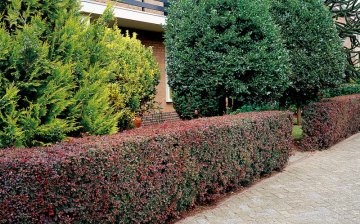
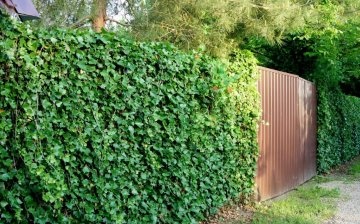




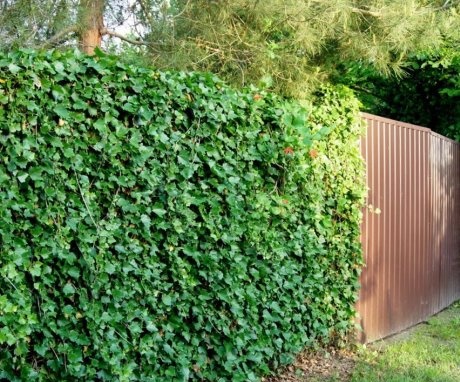
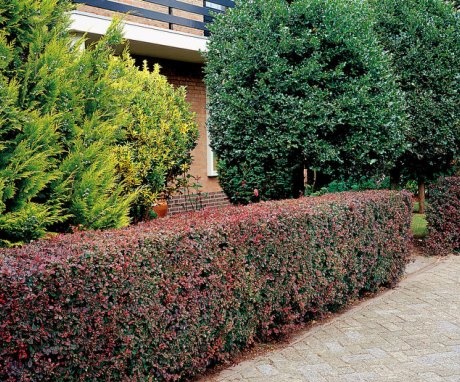
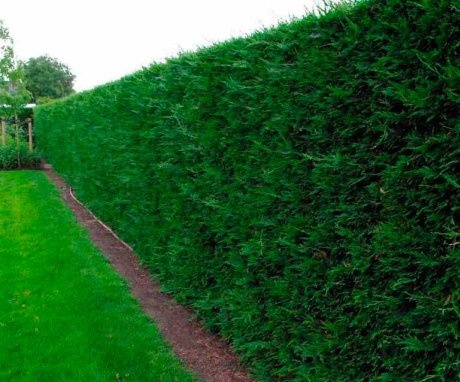
Thuja makes a very beautiful fence, but do not forget that a normal fence, a traditional one, they still will not replace you, it is more like a design design, if you want something unusual.
For the device of a hedge, barberry is very suitable, especially with red leaves. In combination with a wrought-iron fence, it will be an incredibly beautiful fence that hides the territory of the site from the eyes of passers-by on the street.
It turns out very aesthetically pleasing. At least all the fences of this format that I saw ennobled everything around. But this is such a hassle according to those who did it. Very careful care is needed and a lot of time is spent on it. Therefore, I just set myself a professional flooring and that's it.
How I like a living fence in the country, especially if it is well-groomed. Previously, lilacs were often used for this, but now more and more often coniferous shrubs. But everything is beautiful and pleasing to the eye.
Having agreed with our neighbors, we have been caring for a "living fence" of hawthorn bushes for about ten years now.
Beautifully, with protective needles, it is very useful, since spring inflorescences and autumn berries help very well in the treatment of hypertension.
My neighbors have an ivy hedge, it looks beautiful (especially when the bunches of berries are hanging) and they are happy - ivy is quite good and tolerates heat and cold, and it is easy to adjust the shape.